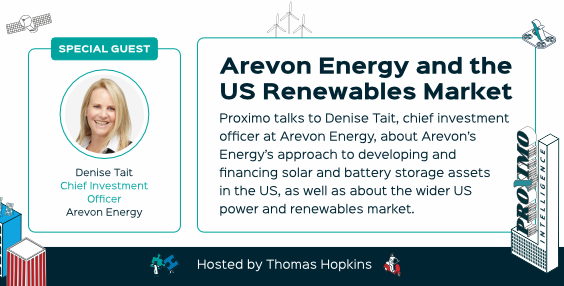AQUIND: Reaching beyond the red tape
Since the launch of Ofgem’s cap and floor regime, HVDC interconnectors have begun to transform into a project finance asset class in the UK. Nevertheless, projects such as the AQUIND Interconnector are still struggling under the weight of a bureaucratic and uncertain permitting process.

The failure of the UK’s latest CfD auction round to deliver a single offshore wind project has certainly reinforced the role interconnectors will need to play in meeting the UK’s decarbonisation targets. But UK interconnectors are proving just as challenging to develop in the face of protracted regulatory approvals. The AQUIND Interconnector has, for example, been in development for almost ten years and may only be operational in 2028, partly due to political decisions that have obstructed its progress towards financial close.
The 2GW interconnector is due to transmit electricity between the UK and France, with interconnection points in Hampshire and Normandy. The project is being developed by AQUIND Limited, a company that exists solely for the purpose of developing the interconnector. The company was originally set up as part of a larger group known as Offshore Group Newcastle Limited, which was itself established to do fabrication work in the oil and gas space.
As its name suggests, Offshore Group Newcastle was based in Newcastle on the North Tyne and secured EPC contracts with several of the oil majors operating in the North Sea. After the oil price slump in 2014, the company exited the oil and gas space and began to explore offshore wind and looked at the possibility of establishing a joint venture with Eiffage. The barriers to entry in the offshore wind sector proved too substantial, however, and the company abandoned the idea of the joint venture, selling its fabrication yard to Smulders Group, a subsidiary of Eiffage.
AQUIND Limited had been established as a vehicle to undertake offshore wind work, but was excised from the main group and set up as a company that would focus on developing an interconnector. Interconnectors appeared to represent a far greater gap in the market in 2014 than offshore wind. Offshore Group Newcastle was also put into administration, with AQUIND becoming the only remaining part of the original group.
On the UK side, the project has made substantial progress, securing a connection agreement with UK transmission system operator (TSO) National Grid ESO, an interconnector licence with Ofgem, and various agreements with the Crown Estate for seabed use. The project was also designated a Nationally Significant Infrastructure Project (NSIP) in 2018. AQUIND has identified converter station locations, landfalls, and cable routes, including marine geophysical and geotechnical surveys of the total length of the marine cable route and ground investigation surveys in France and the UK. Additionally, AQUIND is in the process of securing permits in France and has signed a connection agreement with French TSO RTE.
The project has been deemed eligible by Ofgem to be considered for the third window of the cap and floor regime. The cap and floor scheme is designed to offer revenue support for privately developed interconnector projects – particularly those not built by TSOs, which have historically developed most interconnectors between the UK and Europe. Essentially, under the cap and floor system, if an interconnector project’s revenues fall below the floor, these revenues are topped up to the floor. Conversely, if a project’s revenues rise above the cap, these excess revenues are paid back by the project. National Grid ESO administers the scheme, with the transmission charges that are billed to consumers rising and falling in line with the level of payments made to or received from interconnector projects.
Secretary of State refuses Development Consent Order
The major stumbling block for AQUIND has been obtaining a Development Consent Order (DCO), which is absolutely essential if the project is to proceed. AQUIND submitted the application in November 2019 on the basis of three to four years of work, particularly on the marine side. The Examining Authority appointed by the Planning Inspectorate reviewed the application between September 2020 and March 2021. In June 2021, the Examining Authority made a recommendation to the Secretary of State for Business, Energy, and Industrial Strategy – a position then held by the now infamous Kwasi Kwarteng – that the project’s DCO should be granted. Against this advice, Kwarteng made the decision not to approve the project in January 2022.
Discussing Kwarteng’s decision, Richard Glasspool, a director at AQUIND, notes: “The decision to refuse the Development Consent Order was made on the basis of a very narrow and a very singular point. It was that we had not considered an alternative interconnection point for the project. We are due to connect to the Lovedean substation and the Secretary of State indicated we had not adequately considered connecting to Mannington substation, a decision which AQUIND disagreed with. National Grid is, however, ultimately responsible for considering the interconnection point and had selected Lovedean as the preferred site.
“We went to Judicial Review and earlier in 2023, the High Court found in our favour and quashed the original decision. The new Secretary of State must now redetermine the application, but there is no statutory deadline by which a final decision must be made. The delays come at a cost to the project and slow progress on a project that will lower electricity costs for consumer, generate jobs and assist with reaching the UK’s net-zero ambitions.”
Mannington, which is 15 miles west of Lovedean, had been contemplated as an interconnection point at one stage, but its capacity had for a time been allocated to the Navitus Bay wind farm. The wind farm subsequently had its application refused under the Planning Act 2008, opening up capacity. In relation to this, the decision letter issued by the Department for Business, Energy, and Industrial Strategy stated: ‘The Secretary of State agrees with the views of Interested Parties that the Applicant should have undertaken further work to assess the feasibility of the Mannington Substation as the grid connection point once it became aware of the consent refusal for the Navitus Bay offshore wind farm project.’
There were, however, other reasons for selecting Lovedean over Mannington, which, in any case, was more the responsibility of National Grid ESO than it was the responsibility of AQUIND. In a letter to the Planning Inspectorate in January 2021, National Grid ESO noted that substation options to the west of Lovedean (such as Mannington) ‘required all or nearly all the same network reinforcements as a connection at Lovedean plus additional reinforcements to either get the power to Lovedean or reinforcements to the west to Exeter substation and as far northwards as Minety.’ The letter clarifies that Mannington was not considered further on this basis.
The legal challenge against Kwarteng’s decision succeeded on four grounds. Writing about these grounds, Angus Walker, a partner at BDB Pitmans, notes: “First, Navitus Bay had not been the sole reason to reject Mannington, it would also have required strengthening the line between there and Lovedean, with all the attendant environmental effects of that, and the Secretary of State ignored that. Secondly and thirdly, the Planning Act 2008 requires checking that projects accord with National Policy Statements. The overarching National Policy Statement for energy has a checklist for how to deal with possible alternatives; the Secretary of State only mentioned two of the eight items on the checklist and ignored the others. Not complying with the Planning Act 2008 and the National Policy Statements were separate grounds in the claim but the judge took them together.
“Finally, there is a general principle that if you are going to decide something you must at least look into it to some extent. Just saying that the Mannington alternative existed fell far short of checking if it was viable for the project, and the judge decided it was irrational to refuse the application on the basis of something the Secretary of State hadn’t explored.”
Financing moves forward in spite of regulatory hurdles
As Glasspool points out, AQUIND is now caught in regulatory limbo as the new Secretary of State Claire Coutinho considers the application. Energy now, of course, falls within the Department for Energy Security and Net Zero and Coutinho was appointed Secretary of State on 31 August 2023. There is no fixed deadline by which Coutinho must make a decision as to whether to grant the DCO for the project.
While reaching financial close on a project financing will be impossible unless and until the project is granted full regulatory approval, AQUIND is nonetheless out to equity investors and banks to line up provisional equity and debt commitments for the project. A project financing for the interconnector is likely to proceed over the course of the next year, with the intention of reaching financial close by the end of 2024. London Bridge Capital is financial adviser to AQUIND Limited.
Debt and equity figures have yet to be finalised, although the total project cost is anticipated to be around £1.35 billion. The project will fall within the third window of UK energy regulator Ofgem's cap and floor scheme, which will support approximately 68% of the project cost. This support will be sufficient to cover the senior debt, offering some certainty to lenders about the availability of revenues to service project debt. The project will not receive a revenue floor on the French side, but should revenues rise above a pre-determined level, these will be shared through a mechanism not entirely dissimilar to the cap on the UK side.
To receive the revenue support afforded by the cap and floor scheme, the AQUIND Interconnector must, like other such projects, be approved by Ofgem through both an Initial Project Assessment (IPA) and a Final Project Assessment (FPA). This process involves a detailed cost-benefit analysis. The IPA decision from Ofgem is scheduled for March 2024, meaning that AQUIND and other projects eligible for consideration as part of the third window remain under review by Ofgem.
The Proximo perspective
It is rather fitting that Mrs Justice Lieven – the judge for AQUIND’s legal challenge to Kwarteng’s decision – wrote in her judgement that ‘there are a number of reasons why the [Secretary of State’s] decision to refuse the application without making further inquiries about the feasibility of Mannington was irrational’. There is little that is rational in the government’s current approach to interconnectors, renewable energy, and decarbonisation targets.
The UK could and should be a global leader in clean energy development, having seen the installation of around 14GW of offshore wind capacity, project financings for the NeuConnect and Greenlink interconnectors, and a non-recourse financing for GRIDSERVE’s EV charging network – the largest-ever transaction of its kind.
This legacy is under threat after the government failed to respond to widely publicised cost pressures facing offshore wind developers and set an administrative strike price in AR5 that was, it is reasonable to assume, too low for developers to make a return, leading to an effective boycott of the auction. The government has also just announced plans to allow the sale of new petrol and diesel cars until 2035, pushing back the original 2030 cut-off date. A source close to the GRIDSERVE financing indicates that lenders had taken comfort from the 2030 deadline in EV charging demand forecasts, casting at least some doubt over future EV charging financings.
As far as interconnectors are concerned, the experience of AQUIND demonstrates just how complex developing an interconnector project remains in the UK. Robust regulation is crucial to all large-scale energy and infrastructure projects, but it does seem absurd that it will have taken 14 years for AQUIND to go from early development to being operational if all goes according to plan from now onwards. Had Kwarteng not taken it upon himself to disagree with the informed opinion of the Planning Inspectorate in January 2022, the project could be almost two years ahead of its current stage of development. As it stands, AQUIND has been waiting nearly four years to receive a Development Consent Order, falling victim to seemingly inexorable bureaucracy.
Referring to the development timelines for interconnectors, Richard Saint, chief executive at London Bridge Capital, says: “Interconnectors can take a very long time to develop. The whole process for development in the UK is underpinned by the Ofgem cap and floor agreement. This has helped to accelerate the development of privately funded interconnectors between the UK and Europe. But the process of getting the cap and floor agreement takes a long time. In France, AQUIND is treated as an independent project and would rely on the provisions of the Trade and Cooperation Agreement. Another key factor is environmental planning and consenting.
“That affects not only interconnectors but other major energy transition infrastructure as well, including offshore wind farms. We have noticed that the time required to secure a DCO has increased dramatically in the past 5 years comparing to the time when that regime was launched about 10 years ago. There does need to be rigorous regulation for these projects, but moving an interconnector project forward has become a very lengthy process. This increases the cost of interconnectors and this is borne by developers and, ultimately by consumers. The project is now awaiting for a new decision of the Secretary of State on its DCO, but it has been an very long process taking into account that the project that is actually rather straightforward.”
Due to the delays faced by AQUIND and rising materials and debt costs, the expected capex of the AQUIND Interconnector has ballooned from £1.2 billion to £1.35 billion. The cap and floor regime will reflect these increases to a degree, as the scheme is designed to account for the actual amount of debt raised and the cost of servicing this debt. But the cap and floor will only support 68% of the project’s cost, meaning additional equity will be needed. The permitting delays have also driven up pre-construction development costs for AQUIND.
Interconnectors like AQUIND are a vital part of the energy transition, transporting intermittent renewable energy from where it is being generated to where it is needed. They also make energy markets more efficient by connecting a greater number of electricity sources to the grid, potentially reducing consumers’ energy bills. The higher capex needed to deliver AQUIND will likely increase its revenue floor, raising the cost to consumers of providing this floor. The project will only go ahead if Ofgem’s cost-benefit analysis yields positive results for consumers, but the extent to which AQUIND can deliver lower bills could be impacted by higher project costs caused by protracted regulatory approvals.
Research from Rabobank shows that the UK only has an interconnectivity rate of 5-10%, meaning that there is enormous scope for further interconnector development. The government’s goal of installing 18GW of interconnector capacity – up from 8.4GW today – by 2030 will drift out of reach if other projects are subjected to the tortuous permitting process experienced by AQUIND. Brexit has not helped matters, as certain governance aspects of the Trade and Cooperation Agreement between the UK and the EU relating to energy have yet to be implemented.
It is difficult to know if the present government’s increasingly dismal track record on clean energy is merely a result of incompetence or of a cynical ploy to politicise green policies ahead of the next UK election. But this scarcely matters; it is more pertinent to reflect that as the government lurches from one inchoate energy policy to the next, the UK is becoming a less favourable environment for energy investment, driving developers and investors to other, more attractive markets.





